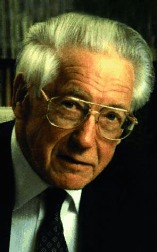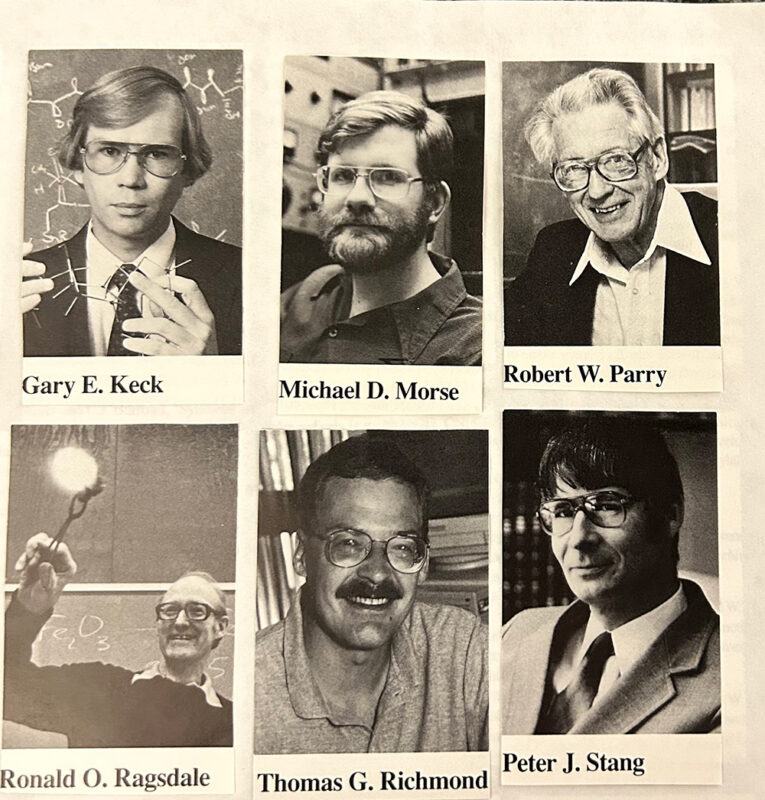 Our former faculty, Robert W. Parry, was recently featured in a Science History Institute article, written by Judith Kaplan and Dennis Sauer. Dr. Sauer completed his postdoctoral studies with Bob Parry at the University of Utah. Distinguished Professor Robert W. Parry was a giant in his profession. He was the founding editor of Inorganic Chemistry in 1960. He served as the President of the American Chemical Society in 1982, won the first Utah Governor’s Medal in Science and Technology in 1987, and received the American Chemical Society’s Priestley Medal in 1993. In his 60-year career, Bob taught thousands of undergrads and mentored over 60 Ph.D. students and postdocs. Together with Henry Eyring and Cheves Walling, Bob played a key role in the growth and development of chemistry at Utah. In 2016 , the Department of Chemistry hosted the inaugural Robert W. Parry Lectureship in Inorganic Chemistry. This annual lecture recognizes Distinguished Professor Bob Parry, one of our most notable former faculty members.
Our former faculty, Robert W. Parry, was recently featured in a Science History Institute article, written by Judith Kaplan and Dennis Sauer. Dr. Sauer completed his postdoctoral studies with Bob Parry at the University of Utah. Distinguished Professor Robert W. Parry was a giant in his profession. He was the founding editor of Inorganic Chemistry in 1960. He served as the President of the American Chemical Society in 1982, won the first Utah Governor’s Medal in Science and Technology in 1987, and received the American Chemical Society’s Priestley Medal in 1993. In his 60-year career, Bob taught thousands of undergrads and mentored over 60 Ph.D. students and postdocs. Together with Henry Eyring and Cheves Walling, Bob played a key role in the growth and development of chemistry at Utah. In 2016 , the Department of Chemistry hosted the inaugural Robert W. Parry Lectureship in Inorganic Chemistry. This annual lecture recognizes Distinguished Professor Bob Parry, one of our most notable former faculty members.
The Science History Institute’s article recognizes Parry’s legacy, specifically his mentorship: “Intensive mentorship helped Robert W. Parry (1917–2006) overcome early economic barriers to achieve an award-winning career in chemistry. He went on to become a leader in chemical education in his own right.” Here’s a snippet from the beginning of the article:
The Influence of Mentors
“All of my education has been governed by finances,” Parry recalled in his oral history. Born in Ogden, Utah, in 1917, Parry’s family nurtured early interests in the physical sciences. These settled decisively on chemistry two years into Parry’s undergraduate education at Weber State College. Forced to step away from coursework when he ran out of money to pay for school, Parry found he could support himself as a chemical analyst with the Forest Service Research Laboratory in his hometown.
 “The thing that made it chemistry for sure was that the Forest Service paid me,” Parry later said of this turning point in his undergraduate education. The job opened doors. Through the Forest Service, Parry met agronomist Rudger H. Walker, who encouraged Parry to continue his studies at Utah State University and helped Parry find a campus job analyzing soils.
“The thing that made it chemistry for sure was that the Forest Service paid me,” Parry later said of this turning point in his undergraduate education. The job opened doors. Through the Forest Service, Parry met agronomist Rudger H. Walker, who encouraged Parry to continue his studies at Utah State University and helped Parry find a campus job analyzing soils.
Walker helped Parry secure several graduate appointments, leading to a master of science degree in soil chemistry from Cornell University in 1942. “He made my life for me…almost,” Parry later said of Walker’s influence. By this time, the United States was mobilizing industry for World War II. DuPont invited Parry to apply his technical skills to the war effort. This took him to DuPont’s new factory in Kankakee, Illinois, where he worked on tetryl, a very dangerous explosive compound that the U.S. Navy used during the war. After DuPont, he joined the Munitions Development Laboratory at the University of Illinois. There, he earned his PhD in inorganic chemistry under John C. Bailar, another chemist known for his commitment to mentoring students.
To read the full article visit here!
Read here “The Robert (Bob) W. Parry Story” from the Univeristy of Utah J. Willard Marriott Library, written by Dennis T. Sauer, Retired Scientist, and
Jean’ne Shreeve, Distinguished Professorat the University of Idaho.
